
By Sabhanaz Rashid Diya
With names like Dr. Nashid Kamal, Mustafa Zaman Abbassi and Ferdausi Rahman in the family tree, Armeen Musa had never been a newbie in the music scene. Although she was being brought up in the backdrop of folk and Nazrul's lyrical masterpieces, she was influenced heavily by rock, alternative beats and world music. When she stepped up as a female vocalist in a local underground band, raised eyebrows weren't big surprises. From Enshrined to her current project, Armeen Musa and the Grasshoppers give us an exclusive insight into what it's like to be a girl 'rockstar' in Dhaka.
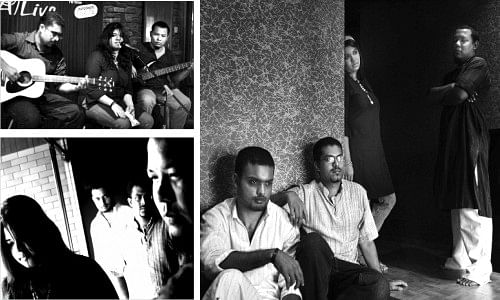 |
Photo: Arif Hafiz |
RS: Let's face it. A band headlining a girl isn't very common in the underground scene. How did it happen?
AM: Well, being from a family like mine, where everyone has been performing in big and small shows at some point or the other. Music was rather encouraged. The underground shows where we performed while growing up, was a very close-nit society. I guess, to be a musician, you just need to have the love, the style and the passion to be so.
 |
Photo: Omar Samdani |
RS: Bangladeshi societies don't really consider it "appropriate" for girls to perform at live concerts. What were the difficulties you had to face as a girl and how did you deal with them?
AM: As far as my family was concerned, performing music was not something frowned upon. All the band members were great friends, and we usually knew most of the people in the audience from school and through friends, so the atmosphere was very comfortable. The only problem was that people were not accustomed to watching or listening to a female vocalist in non-commercial genres. So, attaining musical acclamation was a little harder. In the larger shows, people were more enthusiastic to listen to the heavier bands. However, I think over the years, the market for soft-rock/pop bands has really expanded.
RS: 'Armeen Musa and the Grasshoppers' is a name that raises curiousity. How come it is headlined by your name, as opposed to just 'The Grasshoppers'?
A&G: Right after we formed the band, we had a show to perform at, so we needed a name for the poster. In midst of one of our practices, Adil jokingly suggested 'grasshoppers'. Fortunately, the rest of us really liked it, and it stuck. We were influenced by Norah Jones and the Handsome Band; thus Armeen Musa and the Grasshoppers!
RS: So, how did you guys start?
AM: My previous cover band, Enshrined, which I had for 3 years split off due to other commitments or moving abroad. I wanted to start something new and work on more original stuff. These musicians were great to jam with, so in summer 2006, we got together, and started performing and recording simultaneously. Although I don't live in Bangladesh, whenever we do get together during holidays, we have a great time! The current line up comprises of Adil (guitars), Bart (bass), Amit (drums), and myself, Armeen (vocals).
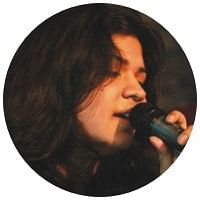 |
Photo: Omar Samdani |
RS: Describe your music in five words. Do you classify it into a genre?
A&G: Randomly speaking: crazy, love, passion, sanctuary and faith. Genres are being formed by each musician everyday. We can't really classify our music. We all are influenced by thousands of millions types of songs. Each of us are influenced by different musical prodigies, however, our common favourites are Arnob, Frou Frou and Mekaal Hasan Band. To narrow it down, Grasshoppers will be a combination Bangla lyric with western pop/rock/jazz/alternative/blues influences.
RS: Do you feel the music scene is now mostly comprised of people who are less serious about their music, and more into the fame aspect of it?
AM: Not really. I grew up playing in the underground scene since I was in class 8 and most of the musicians and bands that performed were very passionate about the music itself. It was a platform for those of us more 'Westernly' influenced to perform and share those songs that inspired us from the rock, alternative and metal scenes from abroad. The criticism, of course, was about being original and more Bangali. But, as the scene progressed and as the bands progress, we all end up making our own songs, mainly in Bangla, some more Bangali, some more Western music influenced.
RS: You've worked with Arnob and several composers for Jhalmuri. Could you give readers an insight about that experience? Was it different from the others?
AM: The Jhalmuri song was composed with Nabila, Dio, Omayr and Nandito, who are very old friends. It was a very fun process as we're all part of different bands/projects and we came together to do this. The end product was Arnob's production. Working with Arnob is a breeze and an experience, because he is immensely professional and it's an honour to see our own stuff being played with by such a great musician.
RS: You've been in Dhaka recently to record another album. Could you give us an insight into it?
AM: The album is called 'AYE GHUM BHANGAI'. It is a collection of some of the songs I wrote growing up, as well as one remake. Each song, in terms of, tune and lyrics, are about different phases and thoughts of my life mainly during my school days. It'll to be released in a couple of months from Bengal Music Company. The Grasshoppers have played in some of the songs, while the others have featured music by many artists from both Bangladesh and England.
RS: What are the band's future plans?
A&G: Hopefully, we'll still be on stage every now and then, covering our favourite songs and performing originals. This is a project rather than a full-time band, so we're always squeezing in different ideas in a very small time frame. Hopefully in future, all of our ideas will ge enough space to come out.
RS: What will be your advice to young girls who want to perform in bands and live concerts?
AM: If you think you have it in you, go for it. There is no greater feeling than being on stage. If you're good, no matter what the audience is, you can come out being at the top of the world!

By Frank Provo, GameSpot

Platform: PC, PS2, PSP
This is an a slightly old game (late 2006) but it is a brilliantly fun game. A long-running gag in the Peanuts comics and cartoons has been Snoopy's fascination with World War I air battles. Specifically, Charlie Brown's pet beagle likes to imagine that he's a famous flying ace engaged in dogfights against the legendary Red Baron. Now, thanks to Namco-Bandai Games, that gag has been made into a video game. Snoopy vs. the Red Baron is a lighthearted take on the air combat genre that lets you take control of the Sopwith Camel and other aircraft, go on missions that primarily involve shooting down swarms of enemy planes, and watch a charming wartime story unfold that features familiar Peanuts characters in the starring roles. Of course, there isn't any sort of "blood and guts." Instead, everyone parachutes to safety when you blow their planes to bits. But don't let that kid-safe tint fool you. Snoopy's game is loaded with intense shooting action that players of any age can appreciate.
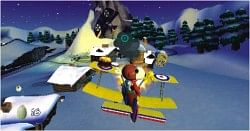 In a nod to the comics and cartoons, the game opens with a scene showing Snoopy asleep on top of his doghouse. Charlie Brown and Lucy walk by and wonder aloud what Snoopy might be dreaming about. When Snoopy sits up and makes rat-a-tat noises, Charlie Brown suggests that he was probably dreaming about being a famous World War I flying ace. As it turns out, that's exactly what Snoopy was dreaming about, and the purpose of the game is to take you on a firsthand journey through Snoopy's fantastic dream. You control Snoopy, as the WWI ace, and go on a campaign of 22 missions for the Allied army, which is struggling to free Europe from the tyranny of the Red Baron and the Central Powers. The game isn't set in the Peanuts gang's hometown--as Snoopy's imagined skirmishes take place in six different locations spread across Britain, France, and Germany--but that doesn't mean the game isn't thick with Peanuts flavor.
In a nod to the comics and cartoons, the game opens with a scene showing Snoopy asleep on top of his doghouse. Charlie Brown and Lucy walk by and wonder aloud what Snoopy might be dreaming about. When Snoopy sits up and makes rat-a-tat noises, Charlie Brown suggests that he was probably dreaming about being a famous World War I flying ace. As it turns out, that's exactly what Snoopy was dreaming about, and the purpose of the game is to take you on a firsthand journey through Snoopy's fantastic dream. You control Snoopy, as the WWI ace, and go on a campaign of 22 missions for the Allied army, which is struggling to free Europe from the tyranny of the Red Baron and the Central Powers. The game isn't set in the Peanuts gang's hometown--as Snoopy's imagined skirmishes take place in six different locations spread across Britain, France, and Germany--but that doesn't mean the game isn't thick with Peanuts flavor.
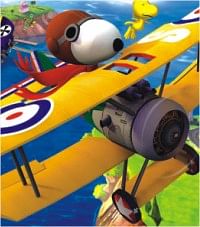 You won't find anything particularly new or innovative while you're playing, but as air combat games go, this one does a good job with tried-and-true concepts. The campaign comprises 22 missions that are split up into multiple segments. In one mission, for example, you have to retrieve a set of plans from a retrieval robot, take the plans back to base, and then escort a blimp carrying Rerun and Linus to safety. Despite the varying goals, missions generally involve shooting down countless numbers of enemy planes and blimps and sinking whatever gunships you come across. Each mission also has a number of secondary goals, such as destroying a certain number of enemy vehicles or collecting a certain number of balloons. The flight controls and combat are best described as easygoing. Snoopy's Sopwith Camel has a primary machine gun with unlimited ammo, as well as a secondary weapon with limited ammo, which you can outfit with bottle rockets, balloon bombs, and other comically inspired weapons. Shooting at enemies is a simple matter of locating them in your gun sight and pressing one of the attack buttons. While you're flying, other buttons let you kick in the turbo or air brakes or perform evasive maneuvers, like a roll, loop, or Immelman turn. You'll be shot down if the Camel takes too much damage, but enemies frequently leave behind root-beer items that you can grab to regain armor. The skies are usually littered with enemy planes, and more appear to replace the ones you shoot down, so there's always something to shoot at.
You won't find anything particularly new or innovative while you're playing, but as air combat games go, this one does a good job with tried-and-true concepts. The campaign comprises 22 missions that are split up into multiple segments. In one mission, for example, you have to retrieve a set of plans from a retrieval robot, take the plans back to base, and then escort a blimp carrying Rerun and Linus to safety. Despite the varying goals, missions generally involve shooting down countless numbers of enemy planes and blimps and sinking whatever gunships you come across. Each mission also has a number of secondary goals, such as destroying a certain number of enemy vehicles or collecting a certain number of balloons. The flight controls and combat are best described as easygoing. Snoopy's Sopwith Camel has a primary machine gun with unlimited ammo, as well as a secondary weapon with limited ammo, which you can outfit with bottle rockets, balloon bombs, and other comically inspired weapons. Shooting at enemies is a simple matter of locating them in your gun sight and pressing one of the attack buttons. While you're flying, other buttons let you kick in the turbo or air brakes or perform evasive maneuvers, like a roll, loop, or Immelman turn. You'll be shot down if the Camel takes too much damage, but enemies frequently leave behind root-beer items that you can grab to regain armor. The skies are usually littered with enemy planes, and more appear to replace the ones you shoot down, so there's always something to shoot at.
Getting through the campaign doesn't take very long, but it's a good ride while it lasts. You can reach the final mission in the better part of a day. There's some incentive to go back and replay missions a few times to increase your rank and to find all of the letters that let you buy more pilots at Pigpen's store. Beyond that, it's fun to replay missions because the combat is exciting and satisfying.
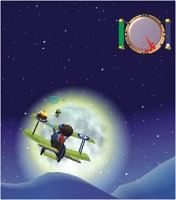 Another satisfying aspect is the game's overall look and feel. There's some mild cel-shading afoot during combat that helps give the action a crude look similar to how Charles Schulz might have animated the game if he were still alive. Seeing Snoopy in the cockpit of the Sopwith Camel and watching the Red Baron and his army fly by in propeller planes from the early 1900's is quite a thrill for a Peanuts fan.
Another satisfying aspect is the game's overall look and feel. There's some mild cel-shading afoot during combat that helps give the action a crude look similar to how Charles Schulz might have animated the game if he were still alive. Seeing Snoopy in the cockpit of the Sopwith Camel and watching the Red Baron and his army fly by in propeller planes from the early 1900's is quite a thrill for a Peanuts fan.
All told, Snoopy vs. the Red Baron is a good example of the right way to produce a video game based on a licensed property. The underlying gameplay provides a nice mix of tried-and-true concepts from the air combat genre, while the integration of the Peanuts characters and situations is handled in a way that's faithful to Charles Schulz's original stories. When you play the game, you really get the idea that you're the famous World War I flying ace piloting the Sopwith Camel to victory against the nefarious Red Baron.
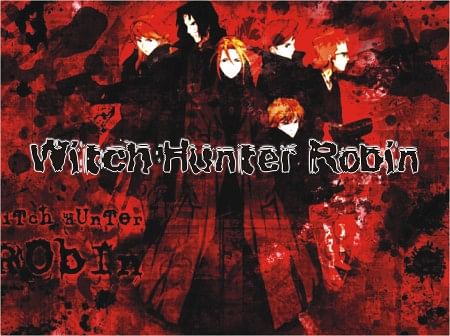
Anime Review By Le Chupacabra
Action / Mystery / Thriller
26 Episodes
Sunrise
Ages 12+
STN-J is the Solomon Organisation's Japanese wing and has worked secretly throughout the ages as a steward for witches and their descendants. As their powers manifest and some go rampant, these arcane individuals often find themselves 'hunted', albeit in a humane way where capture takes precedence over kill. However, recent upsurges in aggressive magical activity in Japan heralds the introduction of the newest hunter to team STN-J: a witch named Robin. Robin's arrival marks the beginning of a sinister ploy and one that may involve a witch coven destroyed three centuries ago.
It's somewhat refreshing to know that Witch Hunter Robin is an anime that was made for TV viewing; it never started off its life as a manga. Without any connotations to bind it, Robin starts off... slowly.
For the first half of the series, one thing is apparent and that's how utterly torpid the plot progression is. A core set of characters are introduced but they do little than interact lightly with one another and hunt witches, following the rather grating “Monster of the Week” theme. However, there is more to be discerned than meets the eye and this is where Witch Hunter Robin's numerous virtues seep in. Fortunately, if you've had the patience to wait until the eleventh episode, you will indeed be richly rewarded as this is where the true story begins. Hints and whispers that were passed off as irrelevant during the initial run now embody a sense of mystery and foreboding and you find yourself drawn deeper in still.
Wispy revelations begin to take corporeal form and character chemistries intensify as a maddening air of intrigue and tension engrosses all. All this culminates in the absolutely breathtaking episode “Time to Say Goodbye” which marks the point where the viewer is truly and utterly drawn into the Witch Hunter Robin mythos. The relentless pace continues on afterwards with a fantastic sense of mystery, further truths and half-truths and gripping action. Suffice to say, the plot finds closure brilliantly and the lingering feeling afterwards is that of gratification and of longing to see the characters in further escapades.
It's peculiar to be honest. What with the lackadaisical inertness of the initial episodes combined with a cast that has little to say, you can't help but be caught off guard when you suddenly realise that the people that make up Witch Hunter Robin are quite human.
I don't know why it comes as a shock but it does. That, I think, is masterful direction. The characterisation is so subtle that it's not until the show's almost over that their motives become apparent to certain degrees and you truly appreciate them as real people.
Witch Hunter Robin is brilliant not only because of an intriguing plot and well-rounded characters but because it wraps it all up in a layer of beautiful countenance. The art style is unique and the designs that permeate throughout from each person to the humble telephone come across as singular and immersive. Speaking of such, the atmosphere is verily palpable with a sense of grit and solemnity. This is further enriched with an evocative soundtrack where soft piano keys find segue with some more jaunty pieces. The intro piece was something I quite enjoyed; a nice rolling song is accompanied by imagery that strikes a keen contrast between colour temperatures. Voicework is something you really take for granted so it's a pleasure when you notice quality beyond the norm. It's not that they are particularly brilliant, it's just that the voices and individual tones fit the characters quite marvellously and this creates a greater sense of being.
Witch Hunter Robin, for all its qualities is a rather unambitious anime. The creators clearly have a fantastic sense of style, story and substance but it's just that they haven't fully explored their creative prowess. It's equally sad that the true essence of the anime is concentrated at the second half; making the sluggish first seem furthermore insignificant and wasted.
However, fans of Loveably Good Anime™ are in for a treat. Witch Hunter Robin is an intriguing, beautiful piece of animation that combines all the necessary ingredients to make a hearty meal that's worth every bite. And the burp afterwards is proof of the quality.
